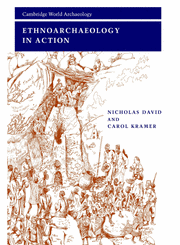Book contents
- Frontmatter
- Dedication
- Contents
- List of figures and credits
- List of tables
- Preface
- Acknowledgments
- Map
- 1 Ethnoarchaeology: its nature, origins, and history
- 2 Theorizing ethnoarchaeology and analogy
- 3 Fieldwork and ethics
- 4 Human residues: entering the archaeological context
- 5 Fauna and subsistence
- 6 Studying artifacts: functions, operating sequences, taxonomy
- 7 Style and the marking of boundaries: contrasting regional studies
- 8 Settlement: systems and patterns
- 9 Site structures and activities
- 10 Architecture
- 11 Specialist craft production and apprenticeship
- 12 Trade and exchange
- 13 Mortuary practices, status, ideology, and systems of thought
- 14 Conclusions: ethnoarchaeology in context
- Bibliography
- Index
1 - Ethnoarchaeology: its nature, origins, and history
Published online by Cambridge University Press: 05 March 2015
- Frontmatter
- Dedication
- Contents
- List of figures and credits
- List of tables
- Preface
- Acknowledgments
- Map
- 1 Ethnoarchaeology: its nature, origins, and history
- 2 Theorizing ethnoarchaeology and analogy
- 3 Fieldwork and ethics
- 4 Human residues: entering the archaeological context
- 5 Fauna and subsistence
- 6 Studying artifacts: functions, operating sequences, taxonomy
- 7 Style and the marking of boundaries: contrasting regional studies
- 8 Settlement: systems and patterns
- 9 Site structures and activities
- 10 Architecture
- 11 Specialist craft production and apprenticeship
- 12 Trade and exchange
- 13 Mortuary practices, status, ideology, and systems of thought
- 14 Conclusions: ethnoarchaeology in context
- Bibliography
- Index
Summary
The problem for archaeologists, it appears, is that they are always too late …
(Tim Ingold 1999: ix)Clearly a bout with ethnography is neither possible nor necessary for everyone.
(Susan Kus 1997: 209, after research among the Merina of Madagascar)We begin by explaining why and how ethnoarchaeology came to be, and give an example from Peru as an illustration of what it is. Then, after explaining the plan of this book, we define the subject and offer a periodized history, concluding the chapter with a glimpse of what it is to be an ethnoarchaeologist.
Why ethnoarchaeology?
Archaeological interpretation is founded and ultimately depends upon analogy – a form of inference that holds that if something is like something else in some respects it is likely to be similar in others. We use it to recognize a flint flake as an artifact or, built into a long chain of reasoning, to impute a tributary mode of production to early civilizations (Trigger 1993: 45–6). Archaeologists draw upon their lives and upon everything they have read, heard about or seen in the search for possible analogies to the fragmentary remains they seek to interpret. By the mid-1950s attention was turning to a new range of questions about the past, to approaches to understanding the patterning in artifact assemblages that would lead beyond cultural chronologies and time-space systematics, the organization of cultural variety into convenient temporally and spatially limited packages such as phases and cultures (Willey and Phillips 1958).
- Type
- Chapter
- Information
- Ethnoarchaeology in Action , pp. 1 - 32Publisher: Cambridge University PressPrint publication year: 2001
- 1
- Cited by

